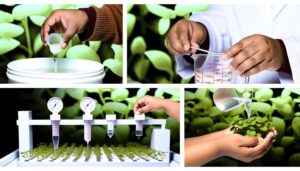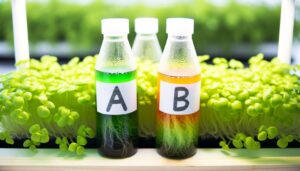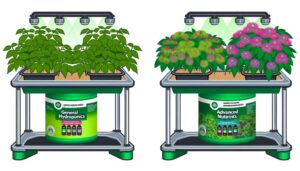Hydroponic Nutrient Solution for Basil
For optimal hydroponic basil growth, maintaining a balanced nutrient solution of essential macronutrients and micronutrients is essential. Key macronutrients include nitrogen (for vegetative growth), phosphorus (root development), and potassium (water uptake).
Micronutrients such as iron, manganese, and zinc are important for enzymatic functions and chlorophyll synthesis. The nutrient solution should have a concentration of 600-800 ppm and maintain a pH between 5.5 and 6.5 to guarantee nutrient availability.
Regular monitoring and adjustments to electrical conductivity, ideally between 1.2 to 1.8 mS/cm, are necessary to prevent deficiencies or toxicities. Explore more to uncover techniques for effectively mixing and maintaining these solutions.
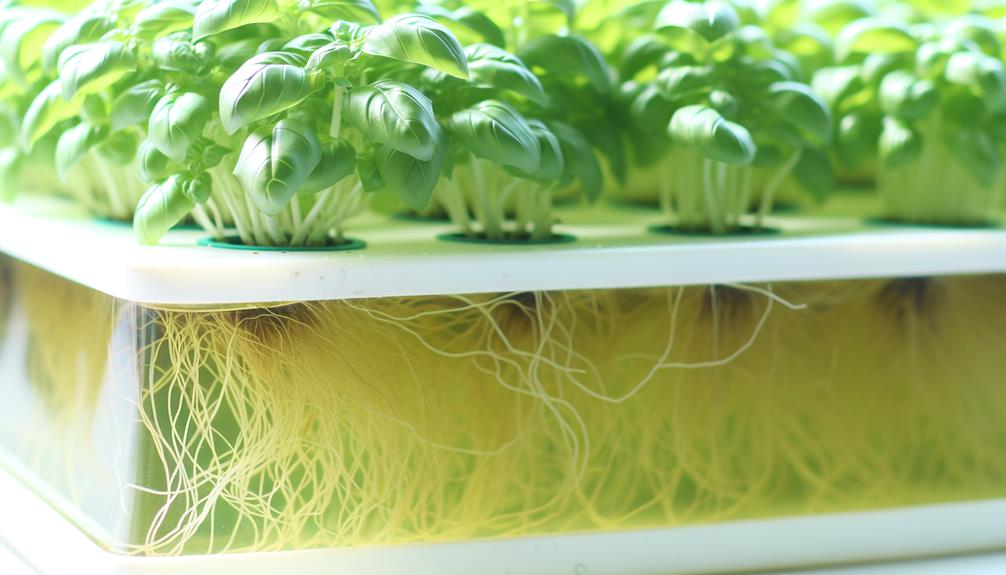
Key Takeaways
- Basil requires a balanced supply of macronutrients (nitrogen, phosphorus, potassium) and essential micronutrients (iron, manganese, zinc) for optimal growth.
- Maintain nutrient solution concentrations between 600-800 ppm and adjust pH to the ideal range of 5.5-6.5.
- Regularly monitor electrical conductivity (EC) to ensure it stays between 1.2-1.8 mS/cm for healthy basil growth.
- Use distilled or deionized water for mixing nutrient solutions to avoid contamination.
Understanding Basil's Nutrient Needs
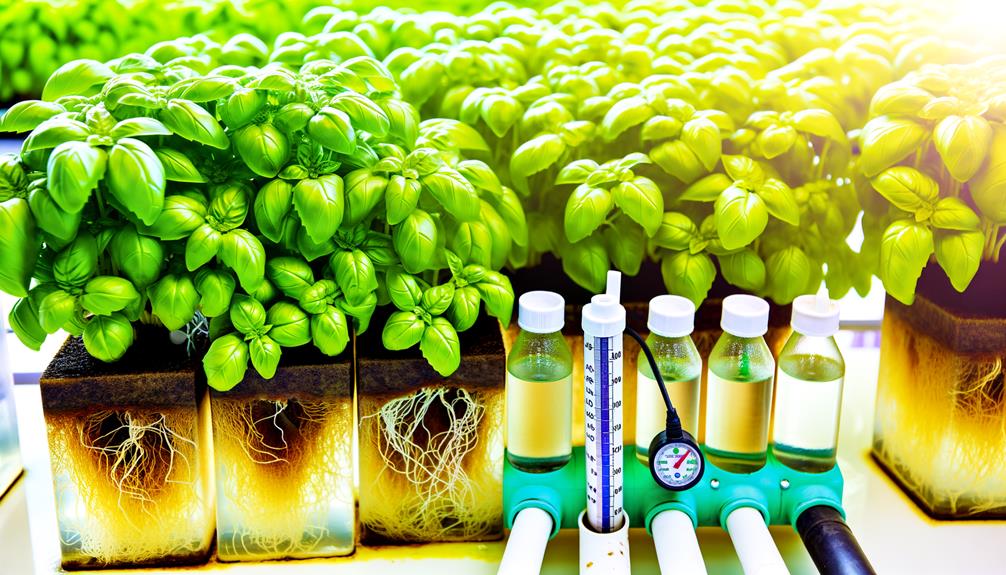
Understanding basil's nutrient needs requires a thorough analysis of the essential macro and micronutrients that support its ideal growth and development in a hydroponic system.
Basil, a nutrient-sensitive herb, demands a balanced supply of nitrogen, phosphorus, and potassium, as well as secondary nutrients like calcium and magnesium.
Key micronutrients such as iron, manganese, and zinc also play significant roles in enzymatic functions and chlorophyll synthesis.
Ideal nutrient concentration and pH levels are critical, as imbalances can lead to deficiencies or toxicities, affecting basil's growth rate and flavor profile.
Hydroponic solutions should be tailored carefully, ensuring consistent monitoring and adjustments to maintain an environment conducive to vigorous, healthy basil plants.
Essential Nutrients for Basil
A well-formulated hydroponic nutrient solution for basil must provide a precise balance of essential macronutrients, including nitrogen, phosphorus, and potassium, along with significant micronutrients like iron, manganese, and zinc.
Nitrogen supports robust vegetative growth and chlorophyll synthesis, while phosphorus is essential for energy transfer and root development. Potassium enhances overall plant health by regulating water uptake and enzyme activation.
Micronutrients, though required in smaller quantities, play crucial roles: iron is necessary for chlorophyll production, manganese aids in photosynthesis and nitrogen assimilation, and zinc contributes to enzyme function and growth regulation.
Ensuring a superior nutrient profile is imperative for maximizing basil's growth potential and maintaining plant health in hydroponic systems. Each element must be carefully calibrated to meet basil's specific physiological demands.
Preparing the Nutrient Solution
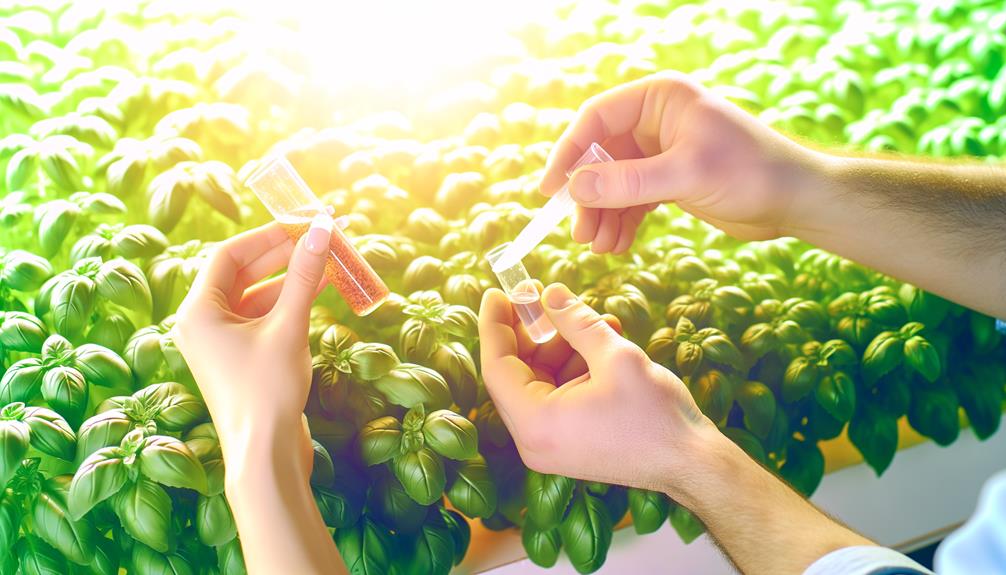
Preparing the nutrient solution for hydroponic basil cultivation requires careful consideration of essential nutrient components and precise mixing procedures to guarantee ideal plant growth.
Key macronutrients like nitrogen, phosphorus, and potassium must be accurately measured and balanced with micronutrients such as iron, magnesium, and zinc.
Detailed mixing protocols, including correct dilution ratios and pH adjustments, are critical to maintaining the nutrient solution's effectiveness and stability.
Essential Nutrient Components
The formulation of a hydroponic nutrient solution for basil necessitates the precise inclusion of macro and micronutrients to guarantee ideal plant growth and health.
Key macronutrients include nitrogen (N), phosphorus (P), and potassium (K), which are crucial for vegetative growth, root development, and overall plant vigor. Additionally, calcium (Ca), magnesium (Mg), and sulfur (S) are essential for structural integrity and enzyme function.
Micronutrients such as iron (Fe), manganese (Mn), zinc (Zn), copper (Cu), boron (B), molybdenum (Mo), and chlorine (Cl) are required in trace amounts but play critical roles in metabolic processes.
Accurate concentrations must be maintained to avoid deficiencies or toxicities, ensuring optimal nutrient uptake and robust basil development.
Mixing Procedures Explained
To guarantee the effective preparation of a hydroponic nutrient solution for basil, it is imperative to follow meticulous mixing procedures that assure accurate nutrient concentrations and homogeneity.
Begin by measuring the required amounts of each nutrient component, based on the specific needs of basil. Dissolve each component in water separately to ascertain complete solubility, beginning with macronutrients like nitrogen, phosphorus, and potassium, followed by secondary and micronutrients.
Utilize distilled or deionized water to prevent contamination. Combine the individual solutions in a large container, continuously stirring to maintain uniform distribution.
Ph Levels and Adjustments
Maintaining an ideal pH range between 5.5 and 6.5 is vital for ensuring nutrient availability and uptake in hydroponically grown basil.
Within this range, nutrients such as nitrogen, phosphorus, and potassium are most effectively soluble, facilitating effective absorption by basil roots.
Deviations from this pH range can lead to nutrient lockout, where essential minerals become insoluble and inaccessible, stunting basil growth and affecting yield quality.
Regular pH monitoring using reliable meters is important, as is the use of pH-adjusting solutions, such as phosphoric acid for lowering pH and potassium hydroxide for raising it.
Adjustments should be made incrementally and precisely, ensuring the solution remains within the best range to support vigorous growth and ideal basil health.
Mixing and Diluting Nutrients
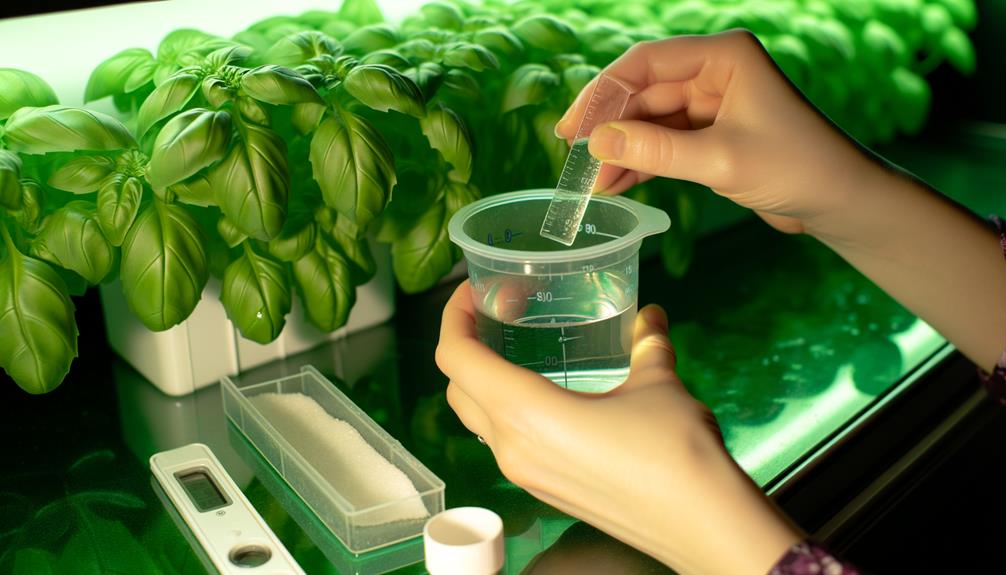
Accurate preparation of hydroponic nutrient solutions involves careful measurement and dilution of concentrated nutrient formulations to achieve ideal concentrations for basil growth.
Precise measurement begins with using calibrated equipment to guarantee exact dosing of macro and micronutrients. Standard practice involves mixing stock solutions in a specified ratio with water, typically using distilled or deionized water to avoid contaminant interference.
The dilution process must account for the recommended parts per million (ppm) for each nutrient, adhering to guidelines based on empirical research. For basil, optimal nutrient concentrations typically range from 600-800 ppm.
Thorough mixing ensures homogeneity, preventing nutrient imbalances. To maintain solution integrity, it is critical to follow manufacturer instructions and validated protocols, guaranteeing consistent nutrient availability for basil's hydroponic cultivation.
Monitoring Nutrient Levels
Effective monitoring of nutrient levels in hydroponic basil cultivation requires precise management of essential nutrient ratios, meticulous pH level maintenance, and rigorous tracking of electrical conductivity.
Accurate nutrient ratios guarantee balanced growth, while maintaining pH levels within an ideal range (5.5-6.5) is vital for nutrient uptake.
Electrical conductivity measurements provide insights into the overall nutrient concentration, guiding necessary adjustments for maximum plant health.
Essential Nutrient Ratios
To optimize the growth and health of basil in a hydroponic system, it is essential to meticulously monitor and adjust the ratios of essential nutrients such as nitrogen, phosphorus, potassium, calcium, and magnesium.
Research indicates that basil thrives with a nitrogen to potassium ratio of approximately 1:1.5, ensuring robust foliage development and essential oil production.
Phosphorus is critical for root development and should be maintained at lower levels relative to nitrogen and potassium.
Calcium and magnesium are important for cell wall integrity and chlorophyll synthesis, respectively, and should be supplied in balanced proportions.
Regular nutrient solution analysis and adjustments, based on empirical growth data, can greatly enhance basil yield and quality.
Ph Level Importance
Maintaining an ideal pH level in the hydroponic nutrient solution is essential for ensuring efficient nutrient uptake and overall health of basil plants. If the pH level drifts too high or too low, basil plants may struggle to absorb essential nutrients, leading to deficiencies and poor growth. To prevent this, growers must regularly monitor and adjust water pH for hydroponics to keep it within the optimal range of 5. 5 to 6. 5. Proper pH management ensures that nutrients remain soluble and readily available for healthy plant development.
Best pH levels for basil typically range between 5.5 and 6.5. Deviations from this range can result in nutrient lockout, where essential elements become unavailable for absorption.
Studies indicate that improper pH levels can lead to deficiencies in key nutrients such as iron, magnesium, and phosphorus.
To maintain the appropriate pH, regular monitoring using reliable pH meters is critical. Adjustments can be made using pH-up or pH-down solutions, ensuring the nutrient environment remains conducive for basil growth.
Consistent pH management supports robust plant development and maximizes yield quality.
Electrical Conductivity Tracking
Accurate tracking of electrical conductivity (EC) in a hydroponic nutrient solution is essential for guaranteeing ideal nutrient availability and preventing imbalances that could impact basil plant health. Regularly measuring EC allows for precise adjustments to the nutrient solution, maximizing growth conditions. The ideal EC range for basil typically falls between 1.2 to 1.8 mS/cm, guaranteeing effective nutrient uptake without the risk of toxicity or deficiency.
| EC Range (mS/cm) | Impact on Basil Growth |
|---|---|
| <1.2 | Nutrient Deficiency |
| 1.2 – 1.8 | Maximum Growth |
| 1.8 – 2.0 | Minor Risk of Toxicity |
| 2.0 – 2.5 | Elevated Toxicity Risk |
| >2.5 | Severe Nutrient Imbalance |
Maintaining EC within this maximum range guarantees robust basil growth, enhancing both yield and quality.
Common Nutrient Deficiencies
In hydroponic basil cultivation, common nutrient deficiencies often manifest as specific physiological symptoms that can greatly impact plant health and yield. Key deficiencies to monitor include:
- Nitrogen Deficiency: Symptoms include yellowing of older leaves and stunted growth. Nitrogen is essential for chlorophyll and amino acid synthesis.
- Potassium Deficiency: Indicated by leaf edge necrosis and curling. Potassium is vital for stomatal function and enzyme activation.
- Magnesium Deficiency: Exhibits as interveinal chlorosis on older leaves. Magnesium is a central component of chlorophyll, affecting photosynthesis.
These deficiencies can be diagnosed through visual inspection and confirmed with nutrient solution analysis.
Addressing them promptly guarantees the basil plants maintain ideal growth and productivity.
Accurate nutrient management is therefore fundamental in hydroponic systems.
Tips for Optimal Growth
To achieve ideal growth in hydroponic basil cultivation, one must meticulously monitor and adjust environmental parameters such as light, temperature, humidity, and pH levels. Light intensity should be maintained at 14-16 hours per day, utilizing full-spectrum LED lights to mimic natural sunlight. Best temperature ranges from 70-75°F (21-24°C), while humidity should be kept between 50-60%. Monitoring and adjusting the pH levels to a range of 5.5-6.5 guarantees nutrient availability and uptake.
| Parameter | Best Range |
|---|---|
| Light | 14-16 hours/day |
| Temperature | 70-75°F (21-24°C) |
| Humidity | 50-60% |
| pH Level | 5.5-6.5 |
Adherence to these parameters promotes robust growth, maximizing yield and quality.
Conclusion
In summation, the meticulous formulation and management of a hydroponic nutrient solution for basil are paramount to achieving ideal growth and yield.
Ensuring an appropriate balance of essential nutrients, maintaining precise pH levels, and diligently monitoring nutrient concentrations can mitigate common deficiencies.
This all-encompassing approach, akin to an alchemist's precision, fosters robust basil cultivation.
Consequently, adherence to these scientific principles is indispensable for maximizing the potential of hydroponic basil production.

